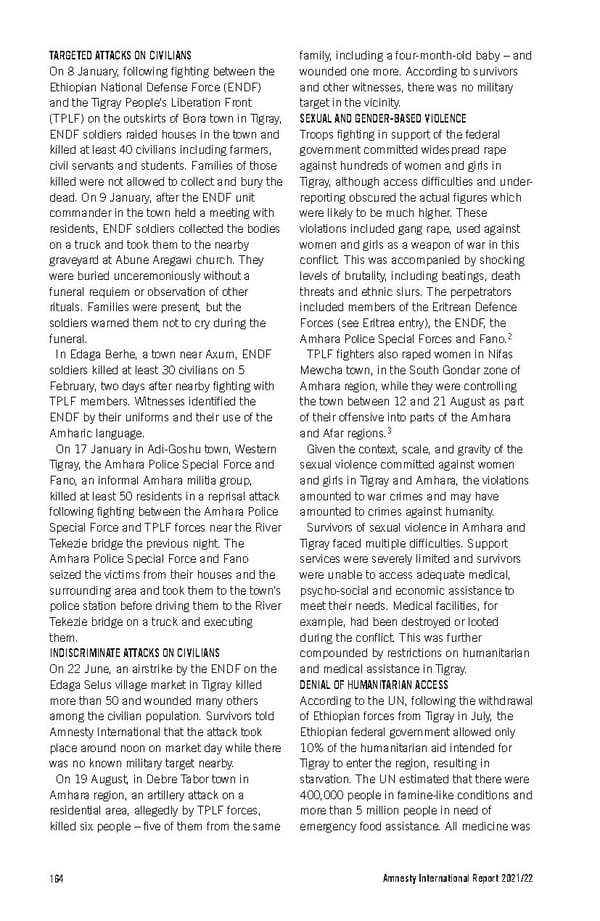TARGETED ATTACKS ON CIVILIANS family, including a four-month-old baby – and On 8 January, following fighting between the wounded one more. According to survivors Ethiopian National Defense Force (ENDF) and other witnesses, there was no military and the Tigray People’s Liberation Front target in the vicinity. (TPLF) on the outskirts of Bora town in Tigray, SEXUAL AND GENDER-BASED VIOLENCE ENDF soldiers raided houses in the town and Troops fighting in support of the federal killed at least 40 civilians including farmers, government committed widespread rape civil servants and students. Families of those against hundreds of women and girls in killed were not allowed to collect and bury the Tigray, although access difficulties and under- dead. On 9 January, after the ENDF unit reporting obscured the actual figures which commander in the town held a meeting with were likely to be much higher. These residents, ENDF soldiers collected the bodies violations included gang rape, used against on a truck and took them to the nearby women and girls as a weapon of war in this graveyard at Abune Aregawi church. They conflict. This was accompanied by shocking were buried unceremoniously without a levels of brutality, including beatings, death funeral requiem or observation of other threats and ethnic slurs. The perpetrators rituals. Families were present, but the included members of the Eritrean Defence soldiers warned them not to cry during the Forces (see Eritrea entry), the ENDF, the 2 funeral. Amhara Police Special Forces and Fano. In Edaga Berhe, a town near Axum, ENDF TPLF fighters also raped women in Nifas soldiers killed at least 30 civilians on 5 Mewcha town, in the South Gondar zone of February, two days after nearby fighting with Amhara region, while they were controlling TPLF members. Witnesses identified the the town between 12 and 21 August as part ENDF by their uniforms and their use of the of their offensive into parts of the Amhara 3 Amharic language. and Afar regions. On 17 January in Adi-Goshu town, Western Given the context, scale, and gravity of the Tigray, the Amhara Police Special Force and sexual violence committed against women Fano, an informal Amhara militia group, and girls in Tigray and Amhara, the violations killed at least 50 residents in a reprisal attack amounted to war crimes and may have following fighting between the Amhara Police amounted to crimes against humanity. Special Force and TPLF forces near the River Survivors of sexual violence in Amhara and Tekezie bridge the previous night. The Tigray faced multiple difficulties. Support Amhara Police Special Force and Fano services were severely limited and survivors seized the victims from their houses and the were unable to access adequate medical, surrounding area and took them to the town’s psycho-social and economic assistance to police station before driving them to the River meet their needs. Medical facilities, for Tekezie bridge on a truck and executing example, had been destroyed or looted them. during the conflict. This was further INDISCRIMINATE ATTACKS ON CIVILIANS compounded by restrictions on humanitarian On 22 June, an airstrike by the ENDF on the and medical assistance in Tigray. Edaga Selus village market in Tigray killed DENIAL OF HUMANITARIAN ACCESS more than 50 and wounded many others According to the UN, following the withdrawal among the civilian population. Survivors told of Ethiopian forces from Tigray in July, the Amnesty International that the attack took Ethiopian federal government allowed only place around noon on market day while there 10% of the humanitarian aid intended for was no known military target nearby. Tigray to enter the region, resulting in On 19 August, in Debre Tabor town in starvation. The UN estimated that there were Amhara region, an artillery attack on a 400,000 people in famine-like conditions and residential area, allegedly by TPLF forces, more than 5 million people in need of killed six people – five of them from the same emergency food assistance. All medicine was Amnesty International Report 2021/22 164
 Amnesty International Report 2021/22 Page 163 Page 165
Amnesty International Report 2021/22 Page 163 Page 165